A | B | C | D | E | F | G | H | CH | I | J | K | L | M | N | O | P | Q | R | S | T | U | V | W | X | Y | Z | 0 | 1 | 2 | 3 | 4 | 5 | 6 | 7 | 8 | 9
This article includes a list of general references, but it lacks sufficient corresponding inline citations. (May 2011) |
| Colditz Castle | |
|---|---|
Schloss Colditz | |
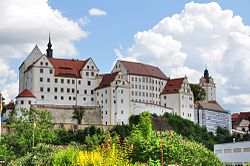 Castle Colditz in 2011 | |
| General information | |
| Architectural style | Renaissance |
| Town or city | Colditz |
| Country | Germany |
| Coordinates | 51°07′52″N 12°48′27″E / 51.1310°N 12.8074°E |
| Client | Augustus of Saxony |
| Owner | State Palaces, Castles and Gardens of Saxony |
| Design and construction | |
| Architect(s) | Hans Irmisch Peter Kummer |

Colditz Castle (or Schloss Colditz in German) is a Renaissance castle in the town of Colditz near Leipzig, Dresden and Chemnitz in the state of Saxony in Germany. The castle is between the towns of Hartha and Grimma on a hill spur over the river Zwickauer Mulde, a tributary of the River Elbe. It had the first wildlife park in Germany when, during 1523, the castle park was converted into one of the largest menageries in Europe.
The castle gained international fame as the site of Oflag IV-C, a prisoner-of-war camp during World War II for "incorrigible" Allied officers who had repeatedly attempted to escape from other camps.
Original castle

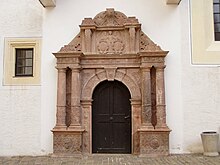
In 1046, Henry III of the Holy Roman Empire gave the burghers of Colditz permission to build the first documented settlement at the site. During 1083, Henry IV urged Margrave Wiprecht of Groitzsch to develop the castle site, which Colditz accepted. During 1158, Emperor Frederick Barbarossa made Thimo I "Lord of Colditz", and major building works began. By 1200, the town around the market was established. Forests, empty meadows, and farmland were settled next to the pre-existing Slavic villages Zschetzsch, Zschadraß, Zollwitz, Terpitzsch and Koltzschen. Around that time the larger villages Hohnbach, Thierbaum, Ebersbach and Tautenhain also developed.
During the Middle Ages, the castle was used as a lookout post for the German Emperors and was the hub of the Reich territories of the Pleissenland (anti-Meißen Pleiße-lands). During 1404, the nearly 250-year rule of the dynasty of the Lords of Colditz ended when Thimo VIII sold Colditz Castle for 15,000 silver marks to the Wettin ruler of the period in Saxony.
As a result of family dynastic politics, the town of Colditz was incorporated into the Margraviate of Meissen. During 1430, the Hussites attacked Colditz and set town and castle on fire. Around 1464, renovation and new building work on the castle were done by order of Prince Ernest, who died in Castle Colditz in 1486. During the reigns of Electors Frederick III the Wise and John the Gentle, Colditz was a royal residence of the electors of Saxony.
Periods of reconstruction and changes in use
During 1504, the servant Clemens the baker accidentally set Colditz afire, and the town hall, church, castle and a large part of the town was burned. During 1506, reconstruction began and new buildings were erected around the rear castle courtyard. During 1523, the castle park was converted into one of the largest zoos in Europe. During 1524, rebuilding of the upper floors of the castle began. The castle was reconstructed in a fashion that corresponded to the way it was divided-— into the cellar, the royal house and the banqueting hall building. There is nothing more to be seen of the original castle, where the present rear of the castle is located, but it is still possible to discern where the original divisions were (the Old or Lower House, the Upper House and the Great House).
The structure of the castle was changed during the long reign of the Elector Augustus of Saxony (1553–86), and the complex was reconstructed into a Renaissance style castle from 1577 to 1591, including the portions that were still in the gothic architectural style. Architects Hans Irmisch and Peter Kummer supervised further restoration and rebuilding. Later, Lucas Cranach the Younger was commissioned as an artist in the castle.
During this period the portal at what is known as the church house was created during 1584, made of Rochlitz Porphyr (rhyolite tuff) and richly decorated in the mannerist style by Andreas Walther II. This dimension stone has been in use in architecture for more than 1,000 years. It was at this time that both the interior and the exterior of "the Holy Trinity" castle chapel that links the cellar and electors' house with one another were redesigned. Soon thereafter the castle became an administrative office for the Office of Colditz and a hunting lodge. During 1694, its then-current owner, King Augustus the Strong of Poland, began to expand it, resulting in a second courtyard and a total of 700 rooms.
During the 19th century, the church space was rebuilt in the neo-classic architectural style, but its condition was allowed to deteriorate. The castle was used by Frederick Augustus III, Elector of Saxony as a workhouse to feed the poor, the ill, and persons who had been arrested. It served this purpose from 1803 to 1829, when its workhouse function was assumed by an institution in Zwickau. During 1829, the castle became a mental hospital for the "incurably insane" from Waldheim. During 1864, a new hospital building was erected in the Gothic Revival style, on the ground where the stables and working quarters had been previously located. It remained a mental institution until 1924.
From 1829 to 1924, Colditz was a sanatorium, generally reserved for the wealthy and the nobility of Germany. The castle thus functioned as a hospital during a long period of massive change in Germany, from slightly after the Napoleonic Wars destroyed the Holy Roman Empire and created the German Confederation, throughout the lifespan of the North German Confederation, the complete reign of the German Empire, throughout the First World War, and until the beginnings of the Weimar Republic. Between 1914 and 1918, the castle was home to both psychiatric and tuberculosis patients, 912 of whom died of malnutrition. The castle was home to several notable figures during its time as a mental institution, including Ludwig Schumann, the second youngest son of the composer Robert Schumann, and Ernst Baumgarten, one of the inventors of the airship.
When the Nazis gained power during 1933, they converted the castle into a political prison for communists, homosexuals, Jews and other people they considered undesirable. Starting 1939,[1] Allied prisoners were housed there.
Use as POW camp
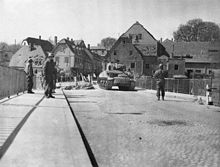

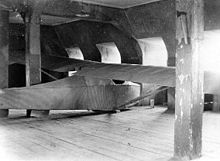
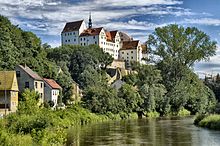
After the outbreak of World War II, the castle was converted into a high security prisoner-of-war camp for officers who had become security or escape risks or who were regarded as particularly dangerous.[4] Since the castle is situated on a rocky outcrop above the River Zwickauer Mulde, the Germans believed it to be an ideal site for a high security prison.
The larger outer court in front of the Kommandantur (commander's offices) had only two exits and housed a large German garrison. The prisoners lived in an adjacent courtyard in a 90 ft (27 m) tall building. Outside, the flat terraces which surrounded the prisoners' accommodation were watched constantly by armed sentries and surrounded by barbed wire. The prison was named Oflag IV-C (officer prison camp 4C) and was operated by the Wehrmacht.[5]
While the camp was home to prisoners of war from many different countries, including Poland, France, Belgium, the Netherlands, and Canada, in May 1943 Wehrmacht High Command decided to house only British and American officers.
The camp's first British prisoners were the Laufen Six on 7 November 1940, who were transferred to Colditz after their first escape attempt from the Laufen Camp.
Although it was considered a high security prison, it had one of the greatest records of successful escape attempts. This could be owing to the general nature of the prisoners that were sent there; most of them had attempted escape previously from other prisons and were transferred to Colditz, because the Germans had thought the castle escape-proof.
One escape scheme even included a glider, the Colditz Cock, that was built and kept in a remote portion of the castle's attic during the winter of 1944–45. The glider was never used, as the camp was liberated not long after its completion. After liberation, the glider was brought down from the hidden workshop to the attic below and assembled for the prisoners to see. Assigned to the task force that liberated the castle, American war correspondent Lee Carson entered Colditz on 15 April 1945 and took the only photograph of the glider completed in the attic.[6] For some time after the war the glider was regarded as a tall tale, as there was no solid proof that the glider had existed and Colditz was then in the Soviet occupation zone in Germany. Bill Goldfinch, however, took home the drawings he had made when designing the glider, and when the single photograph finally surfaced, the story was taken seriously.
During 1999, a full-sized replica of the glider was commissioned by Channel 4 Television in the UK and built by Southdown Aviation Ltd at Lasham Airfield, closely following Goldfinch's drawings. Watched by several of the former prisoners of war who worked on the original, it was test-flown at RAF Odiham during 2000. The escape plan could have worked.[7] In 2012, Channel 4 commissioned another full-sized replica of the glider which was launched from the same roof as had been planned for the original. The unmanned radio-controlled replica made it across the river and landed in a meadow 180 metres below.[8][9]
Captain Pat Reid, who successfully escaped from Colditz in 1942, went on to write multiple works on the living conditions and various escape attempts at Colditz from 1940 to 1945: The Colditz Story and The Latter Days at Colditz. In the early 1970s, he served as a technical consultant for a BBC television series, Colditz (1972), featuring David McCallum, Edward Hardwicke and Robert Wagner, that focused on life at Colditz.
During the last days of the prison camp at Colditz, many of its prominent or high-ranking prisoners were transferred to Laufen by order of Himmler. In April 1945, U.S. troops entered the town of Colditz and, after a two-day fight, captured the castle on 16 April 1945. In May 1945, the Soviet occupation of Colditz began. According to the agreement at the Yalta Conference it became a part of East Germany. The government turned Colditz Castle into a prison for local criminals. Later, the castle was a home for the aged and a nursing home, as well as a hospital and psychiatric clinic. For many years after the war, forgotten hiding places and tunnels were found by repairmen, including a radio room established by the French POWs, which was then "lost" again to be rediscovered some twenty years later.
Notable occupants
 Gp Capt Douglas Bader, RAF flying ace, double leg amputee and subject of the documentary book and film Reach for the Sky
Gp Capt Douglas Bader, RAF flying ace, double leg amputee and subject of the documentary book and film Reach for the Sky Capt Micky Burn, No. 2 Commando, journalist and writer
Capt Micky Burn, No. 2 Commando, journalist and writer Lt Charles Hope, 51st (Highland) Division, 3rd Marquess of Linlithgow
Lt Charles Hope, 51st (Highland) Division, 3rd Marquess of Linlithgow 2Lt Desmond Llewelyn, Royal Welch Fusiliers, later known as the actor playing Q in 17 James Bond films
2Lt Desmond Llewelyn, Royal Welch Fusiliers, later known as the actor playing Q in 17 James Bond films Lt Airey Neave, Royal Artillery, later Lt Col and Conservative MP
Lt Airey Neave, Royal Artillery, later Lt Col and Conservative MP Lt Col David Stirling, founder of the Special Air Service
Lt Col David Stirling, founder of the Special Air Service Capt Charles Upham VC and bar, 20th Battalion, the only fighting soldier to be awarded the Victoria Cross twice.
Capt Charles Upham VC and bar, 20th Battalion, the only fighting soldier to be awarded the Victoria Cross twice. Capt Pat Reid, Royal Army Service Corps, one of the Laufen Six then British escape officer at Colditz, before writing about his experiences
Capt Pat Reid, Royal Army Service Corps, one of the Laufen Six then British escape officer at Colditz, before writing about his experiences Capt Kenneth Lockwood, Royal West Surrey Regiment, one of the Laufen Six then part of the escape team at Colditz
Capt Kenneth Lockwood, Royal West Surrey Regiment, one of the Laufen Six then part of the escape team at Colditz Col William Schaefer, U.S. Army
Col William Schaefer, U.S. Army Gen Tadeusz Bór-Komorowski, Head of Polish Underground Army
Gen Tadeusz Bór-Komorowski, Head of Polish Underground Army Gen Jean Flavigny, Notable Tank Commander from the Battle of France
Gen Jean Flavigny, Notable Tank Commander from the Battle of France Gen Georges Bergé, co-founder of the Special Air Service
Gen Georges Bergé, co-founder of the Special Air Service Flt Lt Josef Bryks, Czech pilot, participant of the Great Escape, before which tried to escape three times.
Flt Lt Josef Bryks, Czech pilot, participant of the Great Escape, before which tried to escape three times.
Present
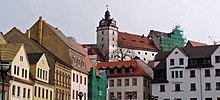
During 2006 and 2007, the castle underwent a significant amount of refurbishment and restoration which was paid for by the state of Saxony. The castle walls were repainted to recreate the appearance of the castle prior to World War II.
With renovations largely completed, the castle now includes both a museum and guided tours showing some of the escape tunnels built by prisoners of the Oflag during the war. The chapel has been restored to its prewar decoration, with glass panels inserted to the flag stone flooring to reveal an escape tunnel dug by French escapees.
The outer courtyard and former German Kommandantur (guard quarters) have been converted into a youth hostel / hotel and the Gesellschaft Schloss Colditz e.V. (the Colditz Castle historical society), founded during 1996, has its offices in a portion of the administration building in the front castle court.
References
- ^ "Oflags". www.lexikon-der-wehrmacht.de. Retrieved 8 April 2018.
- ^ P. R. Reid "The Latter Days at Colditz", chapter XXV
- ^ P. R. Reid "Colditz: The Final Story", photograph caption
- ^ Baybutt, Ron; Lange, Johannes (1982). Colditz: The Great Escapes. Little, Brown. p. 8. ISBN 0316083941.
- ^ Eggers, Reinhold (1961). Gee, Howard (ed.). Colditz: The German Story. London: Robert Hale & Company. p. 184. ISBN 0-7091-3643-9.
- ^ "Lee Carson". American Air Museum in Britain. Retrieved March 19, 2024.
- ^ South African R/C Modeller Issue 12. P. 16
- ^ "Escape from Colditz - Windfall Films". www.windfallfilms.com. Retrieved 8 April 2018.
- ^ "Escape from Colditz - Department of Engineering". www.eng.cam.ac.uk. 6 August 2012. Retrieved 8 April 2018.
- Bibliography
- Baybutt, Ron, and Johannes Lange. Colditz: The Great Escapes. Boston: Little, Brown, 1982. ISBN 0316083941
- Booker, Michael. Collecting Colditz and Its Secrets. London: Grub Street, 2005. ISBN 1-904943-08-X p. 32
- Reid, P. R. 1953. The Latter Days. Hodder & Stoughton. Also as The Latter Days at Colditz, 2003, Cassell Military Paperbacks. ISBN 978-1-4072-1466-5.
- Reid, Patrick. Colditz: The Full Story. New York: St. Martin's, 1984. ISBN 0-312-00578-4 pp. 124, 259–263
- Schädlich, Georg Martin, Tales from Colditz Castle. Thomas Schädlich/Colditz Society, 2000. pp. 4–6, 27, 61, 63, 91–101.
- "What is special about Colditz Castle?" from the Gesellschaft Schloss Colditz e.V. homepage Retrieved March 19, 2005.
- Colditzer Schlossgeschichte "Colditz Castle Story" from the same homepage. Retrieved March 19, 2005.
- Further reading
External links
- Official Society Colditz Castle homepage
- Detail Aerial Photograph Detail from an aerial photograph of Colditz Castle in Saxony, Germany, on 10 April 1945 just three days before U.S. forces overran the area. Individual prisoners can be seen in the photograph
- Karl Höffkes German film archive Newsreel from a private archive: Two minutes of film of the castle and prisoners during World War II starts at timestamp 10:14:37
- Museum Digital: Schloss Colditz with photos of Allied prisoners-of-war, art and other objects
>Text je dostupný pod licencí Creative Commons Uveďte autora – Zachovejte licenci, případně za dalších podmínek. Podrobnosti naleznete na stránce Podmínky užití.
Wikipedia:Citing sources#Inline citations
Wikipedia:WikiProject Reliability
Wikipedia:When to cite
Help:Maintenance template removal
File:Colditz Castle 2011.jpg
File:Germany adm location map.svg
Renaissance architecture
Colditz
Germany
Geographic coordinate system
Augustus, Elector of Saxony
State Palaces, Castles and Gardens of Saxony
Hans Irmisch
File:Colditz Castle 1828 by Ernst Ferdinand Oehme, Albertinum, Dresden.jpg
Ernst Ferdinand Oehme
Albertinum
Renaissance architecture
Castle
Colditz
Leipzig
Dresden
Chemnitz
States of Germany
Saxony
Germany
Hartha
Grimma
Hill spur
Zwickauer Mulde
Menagerie
Oflag IV-C
Prisoner-of-war camp
World War II
Allies of World War II
File:Question book-new.svg
Wikipedia:Citing sources
Wikipedia:Verifiability
Special:EditPage/Colditz Castle
Help:Referencing for beginners
Wikipedia:Verifiability#Burden of evidence
Help:Maintenance template removal
File:Schloss colditz wappen.JPG
Augustus, Elector of Saxony
Anne of Denmark, Electress of Saxony
File:Entrance of Colditz Castle chapel.jpg
Mannerism
Tuff#Rhyolitic tuff
Henry III, Holy Roman Emperor
Holy Roman Empire
Burgher (social class)
Henry IV, Holy Roman Emperor
Margrave
Wiprecht of Groitzsch
Frederick I, Holy Roman Emperor
Slavic peoples
Großbothen
Zschadraß
Thierbaum
Löbau-Zittau
Saale-Holzland
Middle Ages
List of German Kings and Emperors
Reich
Altenburg
Meißen
Altenburger Land
Colditz (Adelsgeschlecht)
Mark (weight)
Wettin (dynasty)
Saxony
Margraviate of Meissen
Hussites
Ernest, Elector of Saxony
Frederick III, Elector of Saxony
John, Elector of Saxony
Rulers of Saxony
Zoo
Prince-elector
Augustus, Elector of Saxony
Renaissance architecture
Gothic architecture
Hans Irmisch
Lucas Cranach the Younger
Tuff#Rhyolitic tuff
Mannerism
Dimension stone
Castle chapel
Jagdschloss
Augustus II of Poland
Neoclassicism
Frederick Augustus III, Elector of Saxony
Zwickau
Mental hospital
Waldheim, Saxony
Gothic Revival architecture
Stable
Sanatorium
Napoleonic Wars
Holy Roman Empire
German Confederation
North German Confederation
German Empire
First World War
Weimar Republic
Tuberculosis
Malnutrition
Robert Schumann
Georg Baumgarten (Luftschiffpionier)
Airship
Nazism
Communism
Homosexuality
Jew
Allies of World War II
File:PicOf 4C LibBridge.jpg
United States Army
File:PicOf 4C Colditz.jpg
File:Originalglider.jpg
Colditz Cock
Lee Carson
File:SCHLOSS COLDITZ1.jpg
Oflag IV-C
Prisoner-of-war camp
Zwickauer Mulde
Terrace (gardening)
Barbed wire
Oflag IV-C
Wehrmacht
Oflag VII-C
List of attempts to escape Oflag IV-C
Attempts to escape Oflag IV-C
Glider (aircraft)
Colditz Cock
Lee Carson
Tall tale
Soviet occupation zone in Germany
Replica
Channel 4 Television
Lasham Airfield
RAF Odiham
Pat Reid
BBC
Colditz (1972 TV series)
David McCallum
Edward Hardwicke
Robert Wagner
Soviet Union
Yalta Conference
East Germany
Nursing home
United Kingdom
Douglas Bader
Royal Air Force
Flying ace
Reach for the Sky
United Kingdom
Micky Burn
No. 2 Commando
United Kingdom
Charles Hope, 3rd Marquess of Linlithgow
51st (Highland) Division
United Kingdom
Desmond Llewelyn
Royal Welch Fusiliers
Q (James Bond)
James Bond
United Kingdom
Airey Neave
Royal Artillery
United Kingdom
David Stirling
Special Air Service
New Zealand
Charles Upham
Victoria Cross
Medal bar
20th Battalion (New Zealand)
United Kingdom
Pat Reid
Royal Army Service Corps
Oflag VII-C
United Kingdom
Kenneth Lockwood
Royal West Surrey Regiment
Oflag VII-C
United States
Poland
Tadeusz Bór-Komorowski
France
Jean Adolphe Louis Robert Flavigny
Free France
Georges Bergé
Czech Republic
Flight lieutenant
Josef Bryks
Stalag Luft III
File:Colditz Castle2 CROPPED.jpg
Pat Reid
Pat Reid
ISBN (identifier)
Special:BookSources/0316083941
Reinhold Eggers
ISBN (identifier)
Special:BookSources/0-7091-3643-9
ISBN (identifier)
Special:BookSources/0316083941
ISBN (identifier)
Special:BookSources/1-904943-08-X
ISBN (identifier)
Special:BookSources/978-1-4072-1466-5
ISBN (identifier)
Special:BookSources/0-312-00578-4
Georg Martin Schädlich
Bibliography of Colditz Castle
Schloss Colditz
Template:Colditz
Template talk:Colditz
Special:EditPage/Template:Colditz
Colditz
Oflag IV-C
Attempts to escape Oflag IV-C
List of attempts to escape Oflag IV-C
Bibliography of Colditz Castle
Q679115#identifiers|class=noprint|Edit this at Wikidata
Q679115#identifiers|class=noprint|Edit this at Wikidata
Help:Authority control
Q679115#identifiers
Colditz Castle
Colditz Castle
Main Page
Wikipedia:Contents
Portal:Current events
Special:Random
Wikipedia:About
Wikipedia:Contact us
Special:FundraiserRedirector?utm source=donate&utm medium=sidebar&utm campaign=C13 en.wikipedia.org&uselang=en
Help:Contents
Help:Introduction
Wikipedia:Community portal
Special:RecentChanges
Wikipedia:File upload wizard
Main Page
Special:Search
Help:Introduction
Special:MyContributions
Special:MyTalk
قلعة كولديتز
Colditz (hrad)
Colditz slot
Schloss Colditz
Κάστρο του Κόλντιτς
Castillo de Colditz
قلعه کلدیتز
Château de Colditz
Caisleán Colditz
Castello di Colditz
Slot Colditz
Colditz slott
کولدٹز قلعہ
Castelo de Colditz
Castelul Colditz
Замок Кольдиц
Colditzin linna
Colditz slott
Colditz Kalesi
科尔迪茨城堡
Special:EntityPage/Q679115#sitelinks-wikipedia
Colditz Castle
Talk:Colditz Castle
Colditz Castle
Colditz Castle
Special:WhatLinksHere/Colditz Castle
Special:RecentChangesLinked/Colditz Castle
Wikipedia:File Upload Wizard
Special:SpecialPages
Special:EntityPage/Q679115
Schloss Colditz
Geographic coordinate system
Colditz Castle
Colditz Castle
Main Page
Wikipedia:Contents
Portal:Current events
Special:Random
Wikipedia:About
Wikipedia:Contact us
Special:FundraiserRedirector?utm source=donate&utm medium=sidebar&utm campaign=C13 en.wikipedia.org&uselang=en
Help:Contents
Help:Introduction
Wikipedia:Community portal
Special:RecentChanges
Wikipedia:File upload wizard
Main Page
Special:Search
Help:Introduction
Special:MyContributions
Special:MyTalk
قلعة كولديتز
Colditz (hrad)
Colditz slot
Schloss Colditz
Κάστρο του Κόλντιτς
Castillo de Colditz
قلعه کلدیتز
Château de Colditz
Caisleán Colditz
Castello di Colditz
Slot Colditz
Colditz slott
کولدٹز قلعہ
Castelo de Colditz
Castelul Colditz
Замок Кольдиц
Colditzin linna
Colditz slott
Colditz Kalesi
科尔迪茨城堡
Special:EntityPage/Q679115#sitelinks-wikipedia
Updating...x
Text je dostupný za podmienok Creative
Commons Attribution/Share-Alike License 3.0 Unported; prípadne za ďalších
podmienok.
Podrobnejšie informácie nájdete na stránke Podmienky
použitia.


